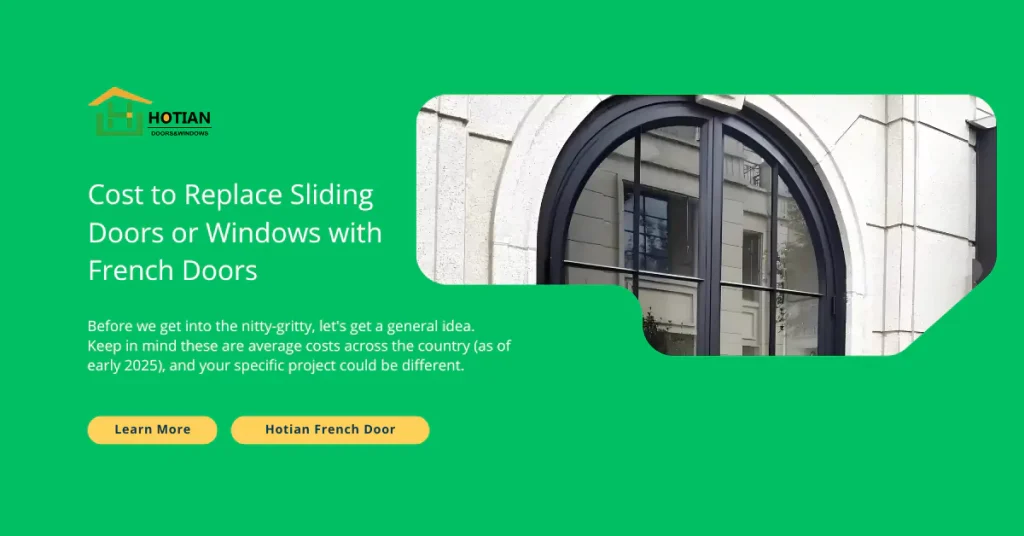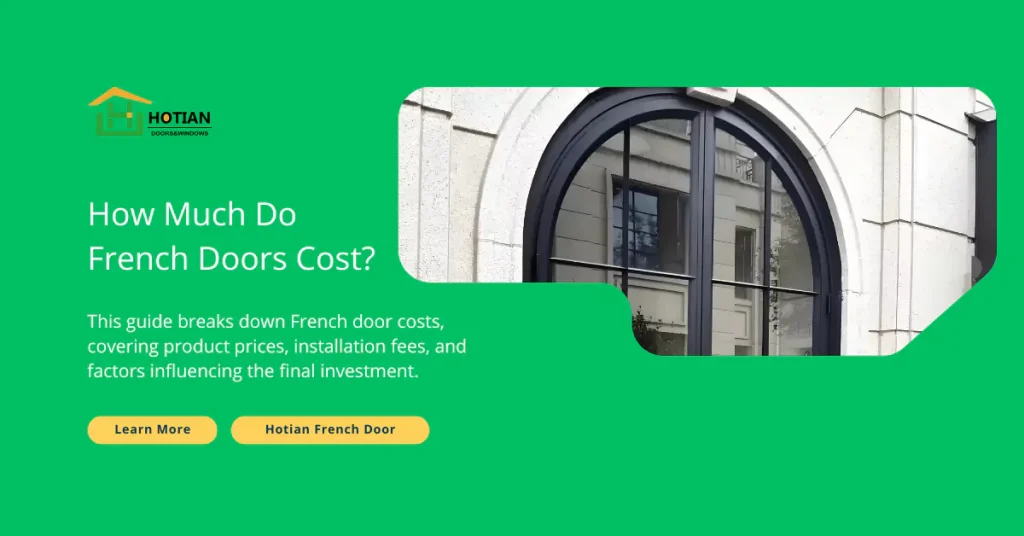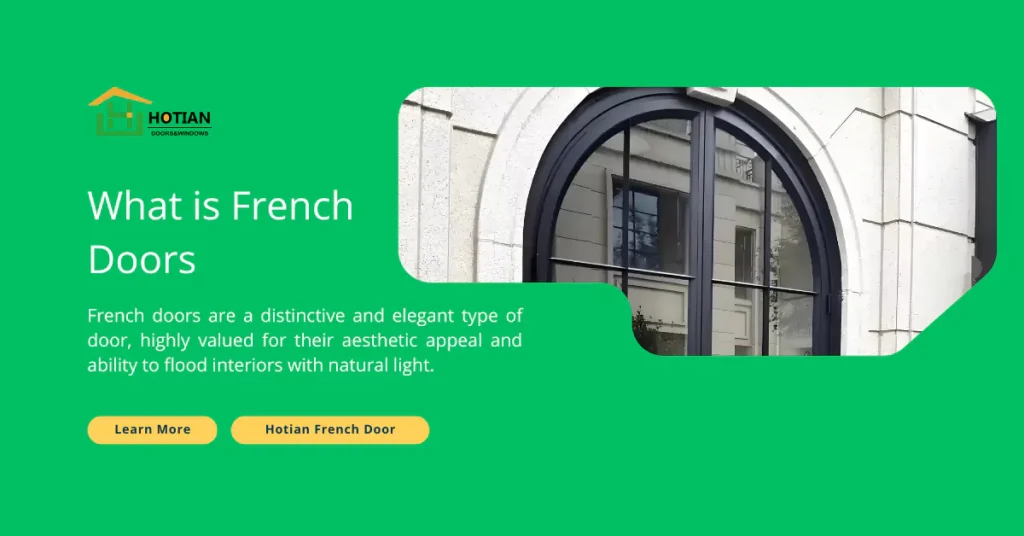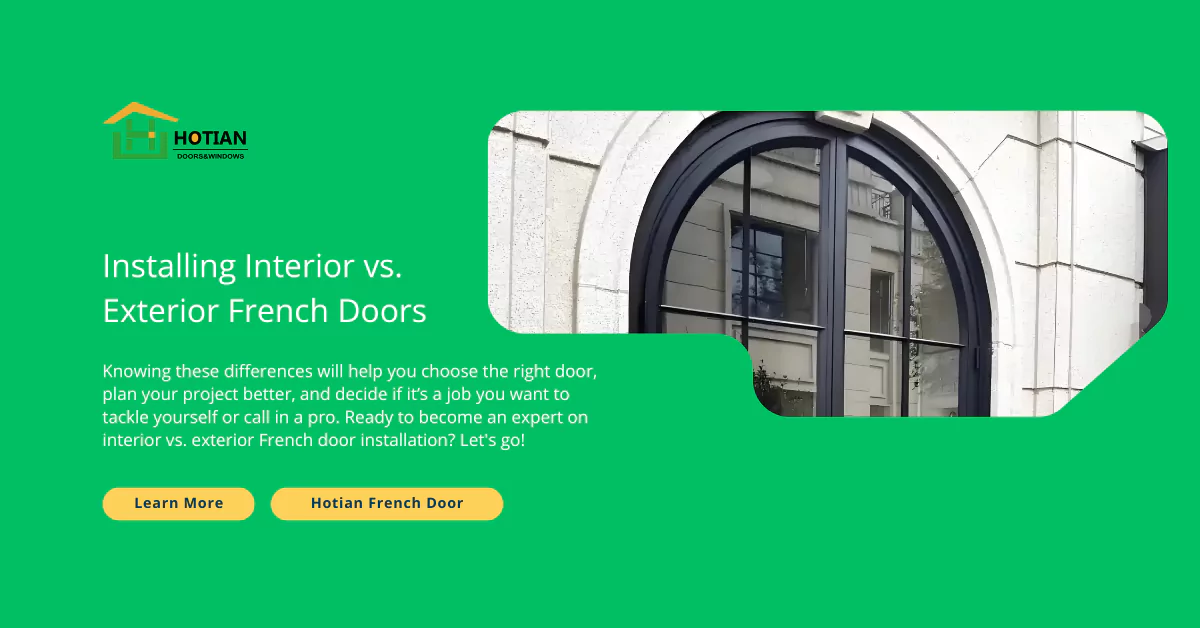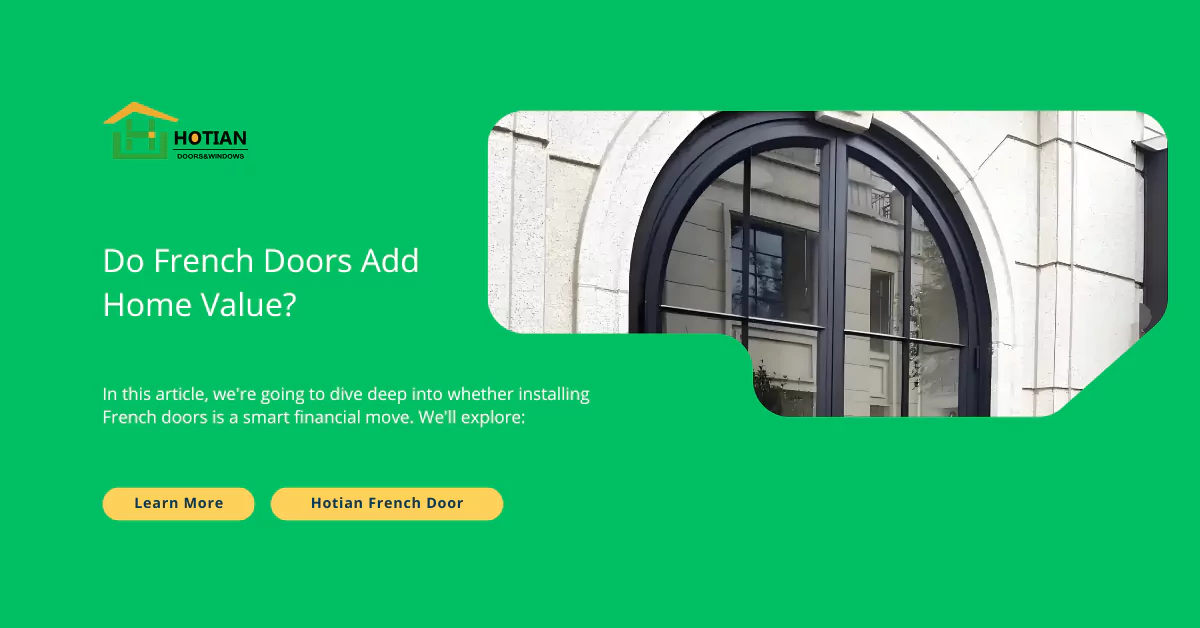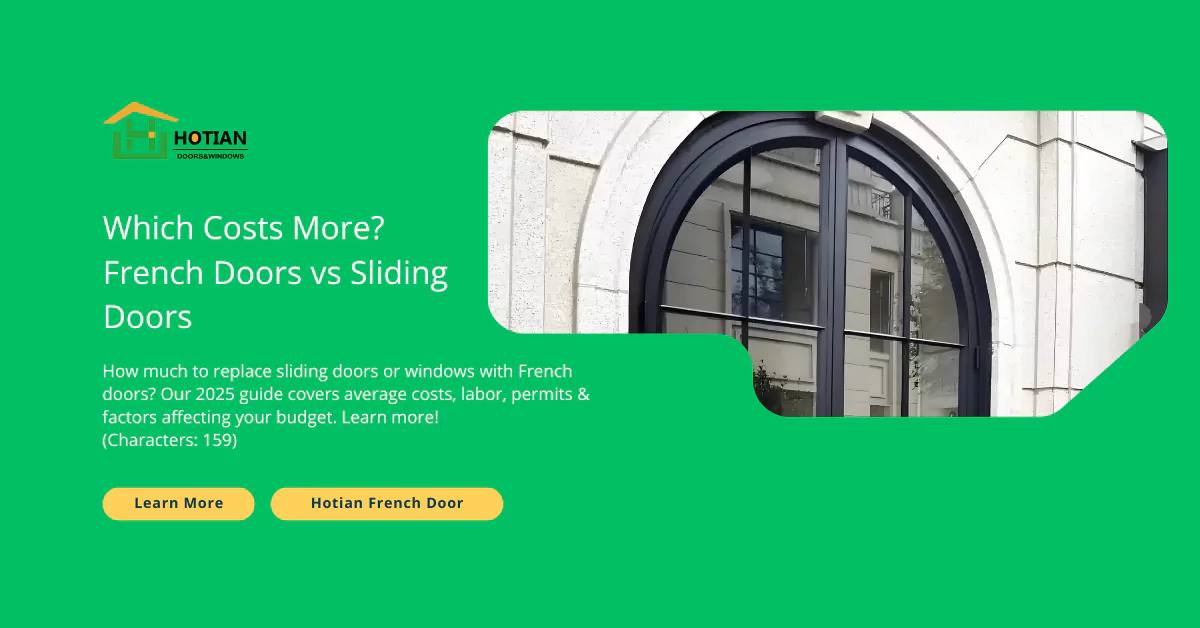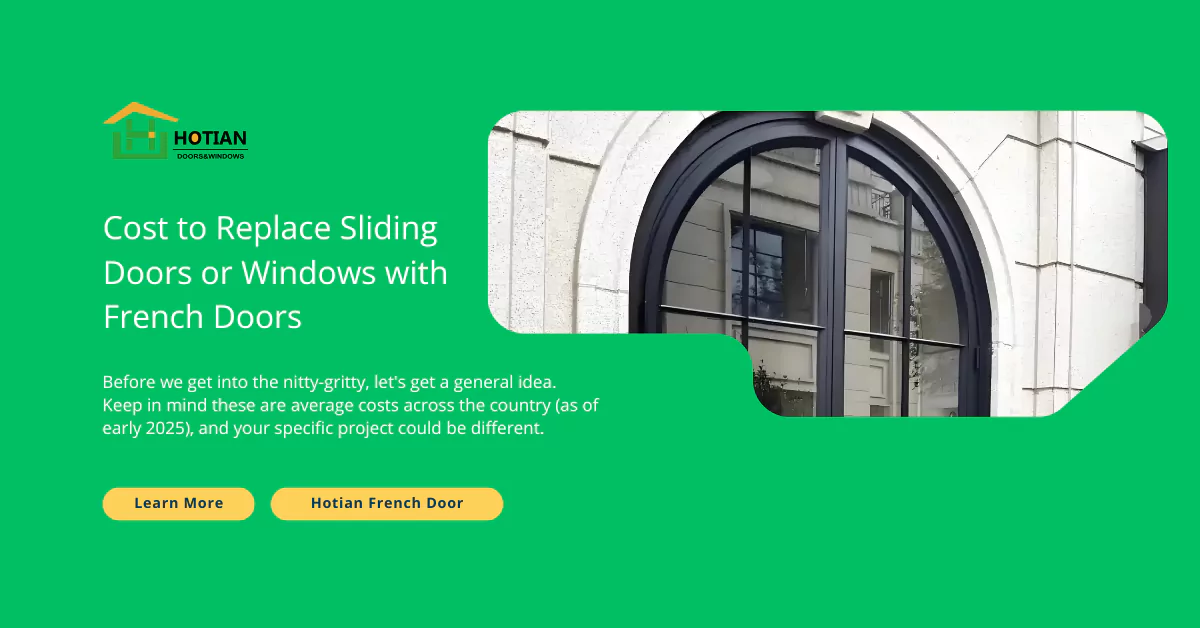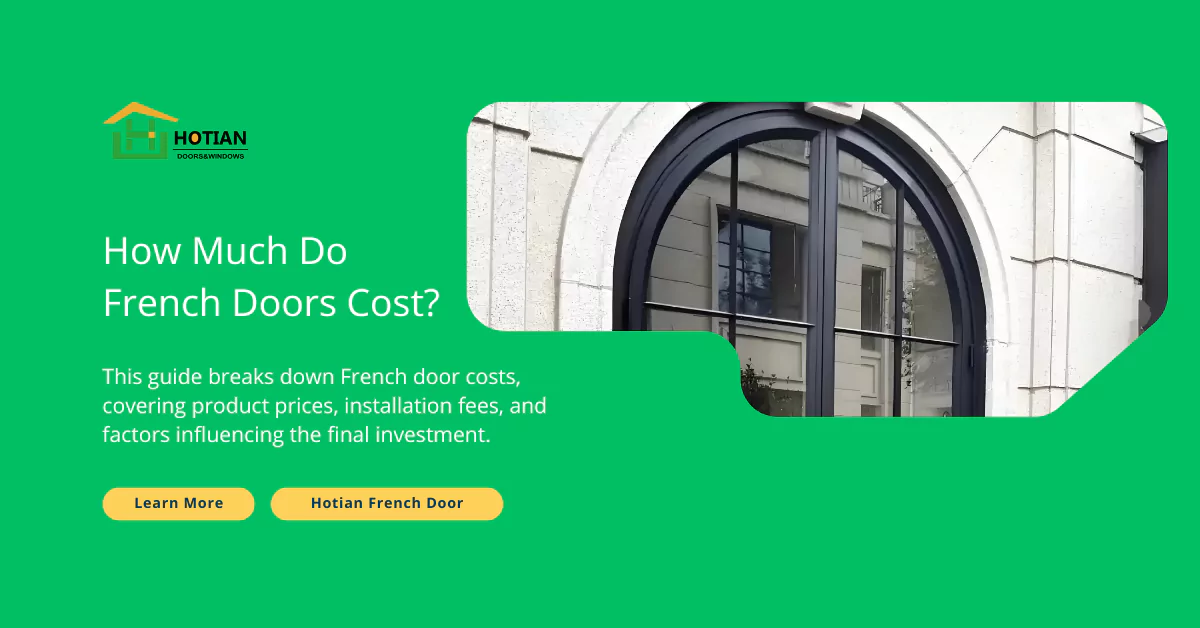Hey everyone! 👋 Thinking about adding or replacing a door that leads to your patio, deck, or backyard? That’s awesome! A great patio door can bring in sunshine, offer amazing views, and make it easy to step outside. ☀️
But when you start looking, you might hear lots of terms: patio doors, French doors, sliding doors, bifold doors… It can get confusing, right? And the biggest question often is: How much do these different doors actually cost? 🤔
You want something that looks great, works well, et fits your budget. Makes sense!
In this guide, we’re going to break down the costs of the most popular types of patio doors. We’ll explore:
- What makes each door type different.
- How much you can expect to pay for the doors et installation.
- What things make the price go up or down (like materials, size, glass).
- Long-term costs like energy savings and maintenance.
- How to decide which door is the perfect fit for ton home and budget.
Ready to figure out the dollars and cents behind patio doors? Let’s dive in! 💰
Introduction: So Many Doors, So Many Choices!
When we talk about “patio doors,” we’re really talking about a category of large doors designed to provide access to outdoor spaces like patios, decks, or gardens. They usually have a lot of glass to let in light and offer views.
The three most common types you’ll bump into are:
- Portes françaises : Classic hinged doors that usually open in pairs.
- Portes coulissantes : Panels that slide side-to-side on tracks.
- Portes pliantes : Panels that fold up like an accordion.
Each one has its own look, way of opening, and, importantly, coût. This article is your friendly guide to understanding those cost differences so you can make a smart choice for your home improvement project. 👍
Understanding Door Types: Let’s Get the Names Straight!
Before we talk money, let’s make sure we know what we’re talking about. Sometimes the names get mixed up!
A. Patio Doors: It’s a Big Family! 👨👩👧👦
Think of “Patio Door” as the family name. It just means any large door, usually with glass, that connects your inside space to your outside space. It’s not one specific taper of door. So, French doors and sliding doors are les deux types of patio doors.
People have used doors to connect to outdoor areas for ages, but the large glass versions we see today became really popular as glass technology got better and people wanted more light and connection to nature.
B. French Doors: Classic Charm ✨
- What are they? Typically, French doors are a pair of hinged doors that swing open from the middle. They don’t have a center post, so when both doors are open, you get a nice wide, clear opening. They often feature multiple panes of glass (called “lites”) in each door panel, though full glass panels are also common. You can learn more about their history and details in our guide: Que sont les portes françaises ?.
- How they look: Think elegant, traditional, maybe a bit formal. They can swing inwards or outwards.
- Key Terms: Hinged, Portes doubles, Inswing/Outswing, Lites (the glass panes).
C. Sliding Doors: Space Savers ↔️
- What are they? Sliding doors usually have two or more large glass panels. One panel stays fixed, and the other(s) slide horizontally on a track.
- How they look: Often seen as more modern or contemporary. They provide a big view without taking up floor space with swinging doors.
- Key Terms: Sliding Panels, Track, Fixed Panel, Contemporain.
D. Other Patio Door Types: The Extended Family
While French and sliding doors are the most common, you might also see:
- Portes pliantes : These have multiple panels that fold neatly against one wall, creating a huge opening. They look very impressive but are usually the most expensive option.
- Telescoping/Multi-Slide Doors: Several panels slide and stack behind each other or into a wall pocket. Also creates a very wide opening and usually comes with a high price tag.
- Portes pivotantes : A large single panel that pivots open on a point near the top and bottom, rather than hinges on the side. Very modern and unique, often costly.
For this guide, we’ll mainly focus on comparing the costs of French doors vs. Sliding doors, as they are the most frequent choices for homeowners.
Comprehensive Cost Comparison: Let’s Talk Numbers! 💲
Alright, here’s the part you’ve been waiting for! How much do these doors actually cost? Keep in mind these are average ranges (as of early 2025) and can change based on many factors.
A. Base Cost Ranges (Door + Standard Installation)
| Type de porte | Typical Base Door Cost Range | Typical Installation Cost Range | Estimated Total Range (Installed) | Remarques |
|---|---|---|---|---|
| Sliding Door (Standard Vinyl) | $400 – $1,200 | $400 – $1,000 | $800 – $2,200 | Most budget-friendly starting point. |
| French Door (Standard Vinyl/Fiberglass) | $600 – $2,500 | $600 – $1,500 | $1,200 – $4,000 | Price varies a lot by material. See French Door Costs. |
| Sliding Door (Mid-Range Fiberglass/Wood Clad) | $1,500 – $4,000 | $600 – $1,500 | $2,100 – $5,500 | Better materials, more features. |
| French Door (Mid-Range Wood/Premium Fiberglass) | $2,000 – $5,000+ | $800 – $2,000+ | $2,800 – $7,000+ | Higher quality materials, potentially larger sizes. |
| Bifold Door (Aluminum/Wood Clad) | $3,000 – $10,000+ | $1,500 – $4,000+ | $4,500 – $14,000+ | Significantly more complex and expensive. |
Key Takeaway: Generally, standard sliding doors are the cheapest option to buy and install. French doors have a wider cost range but typically start higher than basic sliders. Bifold doors are usually in a much higher price bracket.
B. Cost Breakdown by Material: What Are They Made Of?
The material your door is made from is a HUGE cost factor.
- Vinyle:
- Avantages : Most affordable, good insulation, low maintenance (no painting needed).
- Inconvénients : Fewer color options (though improving), can look less “premium,” might warp in extreme heat over time.
- Cost Range (Door Only): Sliding ($400-$1,200), French ($600-$2,000).
- Aluminium:
- Avantages : Strong yet lightweight, slim frames (more glass view), good for modern styles, durable in moderate climates.
- Inconvénients : Not the best insulator (can transfer heat/cold), can corrode in salty air.
- Cost Range (Door Only): Sliding ($800-$2,500), French ($1,500-$3,500+), Bifold ($3,000+).
- Fibre de verre:
- Avantages : Excellent insulator, very durable (resists dents, warping, rot), low maintenance, can be painted, can mimic wood grain convincingly. Great all-around choice!
- Inconvénients : More expensive than vinyl.
- Cost Range (Door Only): Sliding ($1,500-$3,500), French ($1,800-$4,500+). Explore Steel vs Fiberglass French Doors.
- Bois:
- Avantages : Beautiful, classic look, natural insulator, can be stained or painted any color.
- Inconvénients : Most expensive, requires regular maintenance (painting/sealing) to prevent rot/warping, especially outside.
- Cost Range (Door Only): Sliding (often wood clad – $2,000-$4,000+), French ($2,500-$6,000+). See French Door Materials & Hardware Guide for wood options.
- Composite:
- Avantages : Mix of materials (like wood fibers and plastic), often durable and low maintenance, good insulation.
- Inconvénients : Can be pricey, quality varies by brand.
- Cost Range (Door Only): Often similar to Fiberglass or high-end Vinyl.
C. Cost Factors: Size and Shape Matter! 📏
- Tailles standards : Doors made in common widths and heights (like 5, 6, or 8 feet wide and 6 feet 8 inches or 8 feet tall) are usually cheaper because they are mass-produced. Need details on French door sizes? Check out French Door Sizes & How to Measure.
- Tailles personnalisées : If you need a door that’s not a standard size (common when replacing old, odd-sized doors or converting windows), expect to pay significantly more for custom manufacturing.
- Number of Panels: For sliding or bifold doors, more panels generally mean higher cost. A standard 2-panel slider is cheaper than a 3- or 4-panel one.
- Épaisseur de la porte : Thicker doors often feel more solid and may offer slightly better insulation or security, sometimes adding to the cost.
D. Cost Factors: It’s All About the Glass! 💎
The glass in your patio door impacts looks, efficiency, and price.
- Number of Panes:
- Single Pane: Very rare now, poor insulation. Avoid.
- Double Pane: Standard today. Two layers of glass with air or gas in between for insulation. Good balance of cost and efficiency.
- Triple Pane: Three layers. Offers the best insulation but costs significantly more and is heavier. Usually only needed in very cold climates.
- Revêtements à faible émissivité : A nearly invisible metallic layer that reflects heat (keeps heat dans during winter, dehors during summer). Adds cost but improves energy efficiency noticeably. Highly recommended!
- Verre résistant aux chocs : Designed to withstand high winds and flying debris (often called hurricane glass). Required by code in some coastal areas. Adds significant cost but provides safety and security.
- Decorative Glass: Frosted, etched, or patterned glass adds style but increases the price.
- Verre de confidentialité : Options like frosted or obscured glass offer privacy while still letting light in. Costs more than clear glass.
E. Cost Factors: Handles, Locks, and Finishes ⚙️
- Matériel: Basic handles and locks are included. Upgrading to fancier designs, stronger materials (like brass), or specific finishes (like oil-rubbed bronze) will add cost. Learn about options in our French Door Hardware Guide.
- Fonctionnalités de sécurité : Multi-point locking systems (common on French doors and higher-end sliders) engage the frame at several points, offering much better security than a single lock. This adds cost but is often worth it. Worried about French door security? See How to Secure French Doors.
- Smart/Connected Options: Want a door that locks with your phone? Smart locks compatible with patio doors are available but add to the overall expense.
F. Regional Cost Variations: Location, Location, Location! 🌎
Where you live affects the price tag:
- Labor Rates: Installation costs are generally higher in major cities and coastal areas (like the Northeast or West Coast) compared to the Midwest or rural South.
- Demand: Areas with lots of construction or home renovation might have higher prices due to demand.
- Climate Needs: If you live somewhere with extreme weather (very hot, very cold, hurricanes), you might need doors with higher performance ratings (better insulation, impact resistance), which cost more.
- Season: Sometimes, contractors might be busier (and potentially pricier) during peak home improvement seasons (spring/summer).
G. Brand Comparison: You Get What You Pay For? 🤔
- Economy Brands: Often found at big box stores. Offer the lowest prices, usually vinyl. Quality and warranty might be basic.
- Mid-Range Brands: Offer a good balance of quality, features, and pr ice. Often have multiple material options (vinyl, fiberglass, maybe wood). Examples include Pella (multiple lines), Andersen (multipl Examples include Marvin, Ho tian, Kolbe, Andersen (A-Series/E-Series). Expect significant ly higher prices.
- Premium Brands: Focus on high-end materials (often wood, high-end fiberglass, clad-wood), custom options, top performance, and longer warranties. Examples include Marvin, Kolbe, Andersen (A-Series/E-Series). Expect significantly higher prices.
Quality Check: Look for good warranty coverage (especially on the glass seal and hardware), smooth operation, solid construction feel, and certifications like Energy Star. Our French Door Buyer’s Guide & Best Brands can help you navigate specific brands.
Installation Cost Factors: Getting the Door In Place 🛠️
Buying the door is only part of the cost – getting it installed correctly is crucial!
A. Professional Installation: Worth the Price?
- Labor Costs: As shown in the table earlier, expect to pay several hundred to a few thousand dollars just for installation labor, depending on the door type and job complexity.
- What’s Included: This usually covers removing the old door (check if disposal fees are extra!), preparing the opening, setting and securing the new door, insulating, sealing/caulking, and installing basic hardware. Finishing work like painting trim might be extra.
- Why Go Pro? Proper installation is KEY for performance. A poorly installed door can leak air or water, be hard to operate, or fail prematurely. Pros have the tools, skills, and knowledge (especially for tricky jobs like ensuring French doors align perfectly or sliders are perfectly level).
B. DIY Possibilities: Can You Do It Yourself?
- Which Doors? Replacing a simple sliding door with another of the exact same size pourrait be DIY-friendly if you have good carpentry skills. Pre-hung French doors can also be manageable for experienced DIYers. Bifold or multi-slide doors? Probably best left to the pros due to their complexity.
- Skills Needed: Measuring accurately, ensuring the opening is plumb (perfectly vertical) and level (perfectly horizontal), shimming correctly, sealing/flashing properly to prevent leaks.
- Défis : Doors are heavy and awkward! Mistakes can be costly (damage the door, cause leaks). Need specialized tools.
- Économies de coûts : You save on labor costs, but factor in your time, tool rental/purchase, and the risk of errors. For a general idea of the steps involved (even for pros), see How to Install French Doors.
C. Installation Challenges by Door Type
- Portes françaises : Need careful alignment so the two doors meet perfectly in the middle and latch correctly. Ensuring the swing path is clear is important.
- Portes coulissantes : The track must be perfectly level for smooth operation. Ensuring a good seal against drafts where panels meet can be tricky.
- Bifold/Multi-Slide: Complex track systems require precise installation for panels to fold/slide smoothly and seal properly. Structural support might be needed for the weight.
D. Retrofitting vs. New Construction: Replacing Old vs. Starting Fresh
- Replacement (Retrofitting): Taking out an old door and putting a new one in the same sized opening. Generally simpler and cheaper installation. However, if you’re changing the taper of door (like Replacing a Sliding Door with French Doors), you might need minor framing adjustments, adding some cost.
- New Construction: Installing a door where there wasn’t one before, or significantly changing the opening size. This involves cutting walls, framing, maybe adding a header (support beam), and patching drywall/siding. Much more complex and costly installation.
Long-Term Cost Considerations: Beyond the Purchase Price ⏳
The upfront cost isn’t the whole story! Think about costs over the life of the door.
A. Energy Efficiency and Utility Savings 💡
- Energy Ratings: Look for the NFRC label!
- Facteur U : Measures how well the door prevents heat loss (lower is better).
- SHGC (Solar Heat Gain Coefficient): Measures how much heat from the sun it blocks (lower is better in hot climates, sometimes higher is okay in cold climates for passive heat).
- Air Leakage: How much air leaks around the door (lower is better).
- Savings: Energy Star certified doors can save you money on heating/cooling bills compared to old, leaky doors. The exact savings depend on your climate, door type, and energy costs, but it can add up over years. Fiberglass and well-sealed Vinyl/Wood doors tend to be efficient. French doors need good seals! Learn how to maximize this: How to Seal & Insulate French Doors.
- ROI: You might recoup the extra cost of energy-efficient features through utility savings over 5-15 years.
B. Maintenance Costs Over Time 🧹
- By Material:
- Vinyl/Fiberglass/Aluminum: Very low maintenance! Just regular cleaning.
- Bois: Needs the most care – regular cleaning, inspection, and periodic repainting or resealing (every few years) to prevent rot and warping. This adds cost and effort.
- By Type: Sliding door tracks need occasional cleaning to prevent sticking. Hinges on French doors might need lubrication.
- Durée de vie: High-quality Fiberglass and Vinyl doors can last 20-30+ years. Wood doors can last a very long time si meticulously maintained, but less so if neglected. Aluminum lifespan varies.
C. Repair and Replacement Part Costs 🔧
- Common Repairs: Sliding doors might need roller replacement. French door hinges or latches might wear out. Glass can break on any type (though impact glass is much tougher). Seals can fail over time (foggy glass).
- Costs: Rollers or basic hardware might be relatively inexpensive to replace. Replacing a whole glass panel, especially insulated or impact glass, can be costly. Bifold/multi-slide parts can be specialized and expensive. Check out common French door issues: French Door Repair Guide.
- Disponibilité: Parts for major brands are usually easier to find than for obscure or economy brands.
D. Home Value and ROI 🏡
- Impact: New, attractive patio doors generally add value to your home and boost curb appeal (or backyard appeal!). They make the home feel updated and desirable.
- Preferences: French doors often have a classic, high-end appeal. Sliding doors are seen as practical and space-saving. Bifolds offer a wow-factor. Market trends vary, but functional, good-looking doors are always a plus. See how French doors impact value: Do French Doors Add Home Value?.
- Recoup Value: You might recoup 50-75% (or sometimes more in hot markets) of the door’s cost when you sell, depending on the project quality and local market.
Special Considerations: Thinking Outside the Box 📦
A few more things to ponder:
- Accessibilité: If someone uses a wheelchair or walker, look for low thresholds (easy to roll over) and hardware that’s easy to operate. ADA compliance might be needed in some cases. French doors can offer a wide opening, but ensure the threshold is low.
- Climat: In hurricane zones, impact resistance and strong wind ratings are crucial (and often required by code). In very cold areas, triple-pane glass and top U-factors matter most. In hot, sunny areas, low SHGC is key.
- Espace: French doors need clear floor space for the doors to swing. Sliding doors need zero floor space to operate. Bifolds need space for the panels to stack.
- Technology: Adding smart locks or integrating with home security systems is possible with many door types, adding cost but also convenience/security.
Decision Framework: Which Door Is Your Winner? 🏆
Okay, decision time! How do you pick?
- If Budget is Tightest: A standard vinyl sliding door is likely your cheapest option upfront.
- For Classic Style & Wide Opening: Portes françaises offer elegance. Be prepared for a wider cost range depending on material (fiberglass is a great balance). Check out French Door Style Ideas.
- For Modern Look & Space Saving: Portes coulissantes are practical and offer big views without eating floor space. Fiberglass or aluminum often fit this style.
- For Maximum Opening & Wow Factor (with big budget): Bifold or multi-slide doors create that indoor-outdoor connection like nothing else, but cost much more.
- Tenez compte de votre climat : Don’t skimp on energy efficiency features (Low-E, good U-factor) appropriate for your region – it pays off long-term.
- Think Long-Term: Factor in maintenance (wood needs more!) and potential repair costs.
Conclusion : faire le bon choix pour votre maison
Choosing a new patio door is a big decision! As we’ve seen, sliding doors generally have the lowest starting cost, while French doors offer classic style but come with a broader price range depending heavily on material and features. Bifold and multi-slide doors represent the premium, high-cost end of the market.
Remember to consider:
- Ton budget (upfront door cost + installation).
- Le style that best fits your home.
- How you use the space (do you need a wide opening? Is floor space limited?).
- Long-term costs like energy efficiency and maintenance.
- Getting quality installation.
Don’t just focus on the cheapest option – think about value, performance, and how much you’ll enjoy the door for years to come!
Ready to explore high-quality French door options? We offer a fantastic selection of beautiful and durable French doors that can be customized to fit your needs and budget. Let us help you find the perfect entrance to your outdoor oasis! ✅
FAQ Section: Quick Answers to Common Questions
- Q: Are French doors always more expensive than sliding doors?
- UN: Usually, yes, when comparing similar quality levels and materials. A basic vinyl slider is almost always cheaper than a basic French door. However, a high-end, feature-packed sliding door could cost more than a very basic French door.
- Q: Does installation cost more for French doors or sliding doors?
- A: Installation for French doors peut cost slightly more because aligning the pair of doors perfectly takes care and skill. However, complex sliding door installations (like large multi-panel units) can also be costly. Standard replacement installation costs are often comparable.
- Q: Which type of patio door adds more home value?
- A: Both new French doors and new sliding doors can add value over old, worn-out doors. French doors are often perceived as more elegant and might add slightly more perceived value in some markets, but a high-quality, functional door of either type is a plus.
- Q: Are bifold doors worth the extra cost?
- A: It depends! If creating the largest possible opening for a true indoor-outdoor feel is your top priority and fits your budget, they can be amazing. But for most homeowners, the high cost makes French or sliding doors more practical.
- Q: What’s the biggest hidden cost when replacing patio doors?
- A: Potential discovery of hidden damage like wood rot around the existing frame once the old door is removed. This requires extra repair work and adds to the cost. Also, needing custom-sized doors can significantly increase the price over standard sizes.
- Q: How much does just the French door unit cost, without installation?
- A: As mentioned, it varies hugely by material and size. A basic vinyl or fiberglass unit might start around $600-$1,800, while a high-end wood French door could be $3,000-$6,000 or more. See our detailed French Door Cost Guide.
Hopefully, this guide helps you feel more confident about comparing patio door costs! Good luck with your project! 😊



